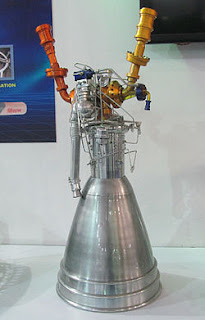MOM=Mars Orbiter Mission
Indian Space Reasearch Organisation (ISRO) is the Space Agency established in 1969 after superseding former "Indian National Commitee for Space Research" (INCOSPAR).It has it's Headquarters located in Bangalore.The ISRO was established in India with an intention or objective of advancing in space research with its application for the benefit of mankind.
Motto:SPACE TECHNOLOGY IN THE SERVICE OF MANKIND***Short Description***
1) ISRO built it's first satellite named "Aryabhatta" which was launched on 19th April 1975 from "Kapustin Yar" through Soviet launch vehicle "Kosmos-3M".It was built with an intention of gaining experience and operating a satellite in space.
2) Later satellite series named "ROHINI" became India's first satellite series to be launched and placed in orbit by Indian made Satellite Launch Vehicle "SLV-3".
3) After this ISRO main objective was to develop it's own launch vehicle capable of carrying desired payloads in orbits.
Satellite Launch Vehicles
1) SLV-3 was a four stage solid fuel light launcher intended to reach a height of 500 kg to carry payload upto 40 kg. Out of it's four test flights only two were successful.
2) Augmented Satellite Launch Vehicle (ASLV) was a 5 stage solid solid propellant rocket capable of carrying a payload upto 150 kg in Lower Earth Orbit (LEO).Out of it's four test flight only two were successful.
3) Polar Satellite Launch Vehicle (PSLV) is an four stage rocket having solid and liquid fuels alternately which enables India to launch "Indian Remote Sensing Satellites"(IRS) .It is most successful satellite launch vehicle of India having 96% success rate.
PSLV CONFIGURATION

4) Geosynchronous Satellite Launch Vehicle (GSLV)is an three stage vehicle with solid liquid and cryogenic stages which enables India to launch "Indian National Satellite System" (INSAT)satellites respectively.It is built with an intention of making India less dependent on foreign satellite launch vehicles.
GSLV CONFIGURATION

5) Geosynchronous Satellite Launch Vehicle Mark-III (GSLV III) is currently under progress & with it's successful launch India will be capable of launching heavy satellite in orbit.
General specification of the Geosynchronous Satellite Launch Vehicle Mk III [GSLV Mk III]

Now here's a image depicting various Satellite Launch Vehicles.
ISRO Launch Vehicle Family

Timeline of Technological advancements being introduced to Indian Satellite Launch Vehicles

Mars Orbiter Mission is a Technology Demonstrator mission developed by ISRO to develop the technologies for designing, planning, management, and operations of an interplanetary mission.It is famously known as "Mangalyaan" which means Mars-Craft in English.The first official announcement by ISRO about the Mars Mission was declared on 23 November 2008 by ISRO Ex-chairman G. Madhavan Nair.The Space and Nuclear Department under Central Government of India approved this project on 3 August 2012.The estimated total project cost was ₹454 crore (US$68 million).The satellite costs ₹153 crore (US$23 million) and the rest of the budget has been attributed to ground stations and relay upgrades that will be used for other ISRO projects.
Primary Objectives
1) Orbit manoeuvres to transfer the spacecraft from Earth-centred orbit to heliocentric trajectory and finally, capture into Martian orbit.
2) Development of force models and algorithms for orbit and attitude computations and analyses3) Navigation in all phases.
4) Maintain the spacecraft in all phases of the mission.5) Meeting power, communications, thermal and payload operation requirements.
6)Incorporate autonomous features to handle contingency situations.
Scientific Objectives
1) Exploration of Mars surface features by studying the morphology, topography and mineralogy.
2) Study the constituents of Martian atmosphere including Methane and CO2 using remote sensing techniques.
3) Study the dynamics of the upper atmosphere of Mars, effects of solar wind and radiation and the escape of volatiles to outer space.
The mission would also provide multiple opportunities to observe the Martian moon Phobos and also offer an opportunity to identify and re-estimate the orbits of asteroids seen during the Martian Transfer Trajectory.Space-Craft Specifications
The specifications of Mars Orbiter are as follows:-
1) Mass:The lift-off mass was 1,350 kg (2,980 lb), including 852 kg (1,878 lb) of propellant.
2) Power:The electricity is generated by Three Solar Array Panels which are made indigenously of 1.8 m × 1.4 m for a maximum of 840 watts of power generation in Mars orbit and that electricity is stored in36 Ah Lithium-ion Battery
3) Propulsion: A liquid fuel engine with a thrust of 440 newtons is used for orbit raising and insertion into Mars orbit. The orbiter also has Eight 22-newton thrusters for attitude control. Its propellant mass is 852 kg (1,878 lb).
4)Bus:The spacecraft bus is a modified l-1K structure and propulsion hardware configuration is as same as Chandrayan-1.
5)Structure:The satellite structure is constructed of an aluminium and Composite Fibre Reinforced Plastic (CFRP) sandwich construction.
Thank you for reading...:) If you liked this then do subscribe and follow...Take care.
















